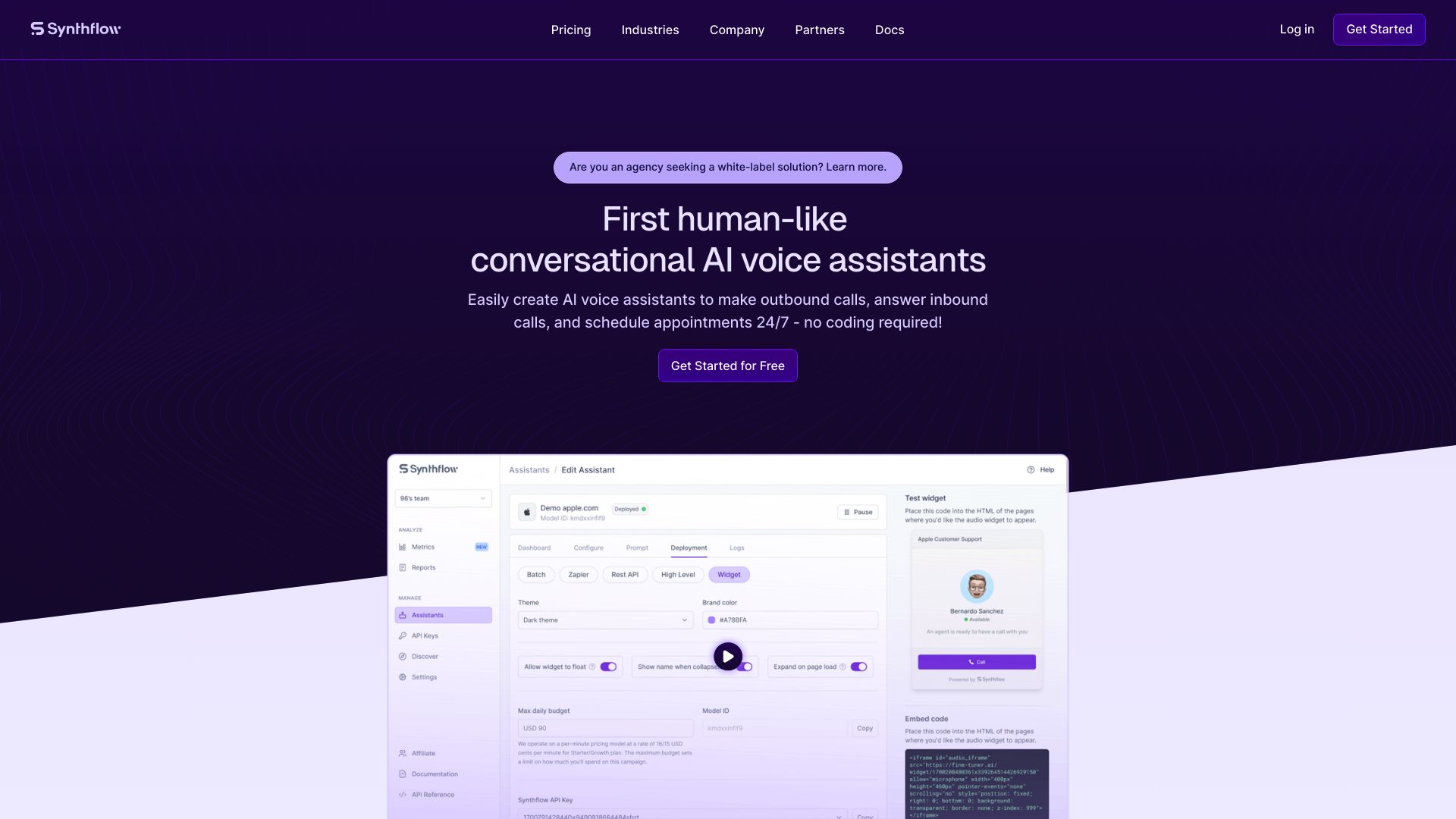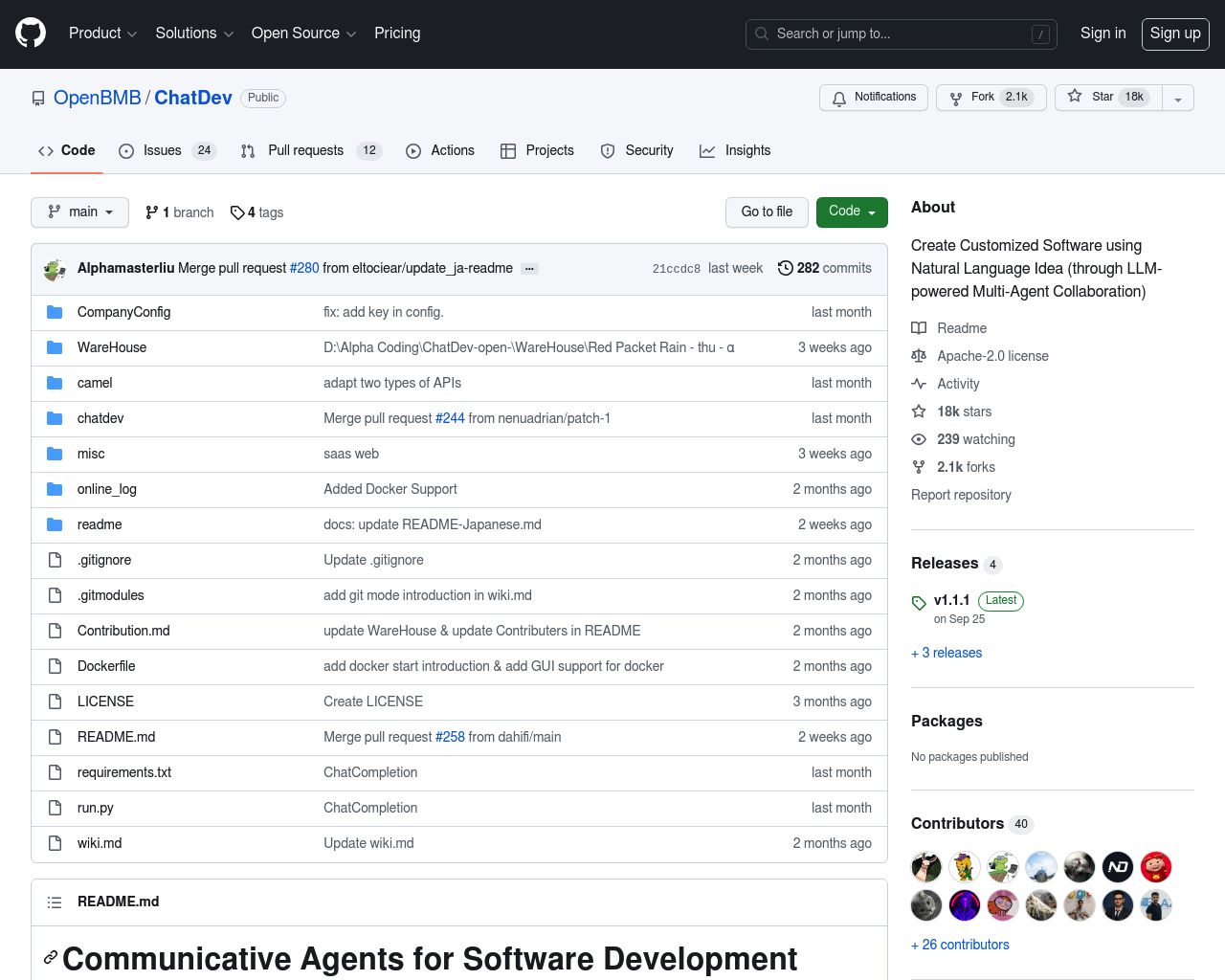Synthflow vs. ChatDev: AI Development Platforms Compared
AI-powered development platforms are transforming how businesses create and deploy intelligent solutions. This comparison explores Synthflow vs. ChatDev, and SmythOS—three innovative platforms reshaping the AI landscape. Synthflow empowers users to build voice assistants without coding, while ChatDev automates entire software development cycles using AI agents. SmythOS stands out by offering a comprehensive suite of tools for creating, deploying, and managing AI agents across multiple channels. We’ll examine each platform’s key features, strengths, and limitations to help you choose the best solution for your AI development needs. Whether you’re a developer seeking efficient coding tools, a business leader looking to enhance customer interactions, or an entrepreneur exploring AI integration, this review provides valuable insights to guide your decision-making process.
Synthflow Overview
Synthflow empowers businesses to create AI voice assistants without coding expertise. The platform’s no-code interface and pre-built templates enable users to deploy customized AI agents for tasks like customer support, lead generation, and appointment scheduling.


Synthflow’s AI assistants maintain context within conversations, personalizing responses and operating autonomously. The platform integrates with tools like 11Labs and Twilio, enhancing functionality. Users benefit from unlimited secure storage in a dedicated Pinecone environment, ensuring data privacy and compliance.
Synthflow empowers businesses to create AI voice assistants without coding expertise. The platform’s no-code interface and pre-built templates enable users to deploy customized AI agents…
Key features include batch deployment for large-scale campaigns, real-time interaction through website widgets, and comprehensive analytics. Synthflow also offers deployment options via GoHighLevel, Zapier, REST API, and direct website integration.
While Synthflow excels in voice AI, it lacks explicit support for multimodal interactions and some advanced features like foundation AI models or specialized classifiers. The platform focuses on accessibility and ease of use, making it particularly suitable for businesses seeking to leverage AI without extensive technical resources.
ChatDev Overview
ChatDev revolutionizes software development by automating the entire process using large language models (LLMs). This open-source framework simulates a virtual software company where AI agents collaborate to design, code, test, and document software projects.
ChatDev leverages a multi-agent system to break down complex development tasks into manageable components. Each AI agent takes on a specific role—such as CEO, CTO, programmer, or tester—mirroring the structure of a real software development team. This approach enables the platform to tackle diverse projects efficiently, from simple applications to more complex software solutions.
ChatDev revolutionizes software development by automating the entire process using large language models (LLMs). This open-source framework simulates a virtual software company where AI agents collaborate…


One of ChatDev’s standout features is its ability to generate a complete software package, including source code, user manuals, and environmental dependencies, in a remarkably short time and at a low cost. For instance, the platform can develop a simple game in under seven minutes for less than one dollar, showcasing its efficiency and cost-effectiveness.
ChatDev’s standout features is its ability to generate a complete software package… in a remarkably short time and at a low cost.
ChatDev employs innovative mechanisms like thought instructions and self-reflection to minimize errors and improve code quality. The framework also supports Git for version control, enabling collaborative and concurrent development practices. These features make ChatDev particularly appealing to developers and companies looking to streamline their software development processes and reduce time-to-market for new applications.
While ChatDev offers impressive automation capabilities, it may require some technical expertise to set up and utilize effectively. The open-source nature of the platform allows for customization and community-driven improvements, but it might lack some of the polished user interfaces and support services found in commercial solutions. As with any AI-driven development tool, careful oversight and quality assurance remain essential to ensure the output meets specific project requirements and coding standards.
Feature Comparison
Synthflow and ChatDev offer distinct approaches to AI-powered development, with notable differences in their core capabilities and target use cases. Synthflow focuses on creating customized AI voice assistants without coding, while ChatDev simulates an entire software development process using AI agents.
Synthflow excels in providing a no-code interface for building voice AI assistants, making it accessible to non-technical users. It offers pre-built templates, batch deployment capabilities, and integrations with tools like 11Labs and Twilio. However, Synthflow lacks explicit support for multimodal interactions and some advanced features like foundation AI models or specialized classifiers.
In contrast, ChatDev takes a more comprehensive approach to software development automation. It leverages large language models to simulate an entire virtual software company, with AI agents collaborating on design, coding, testing, and documentation. ChatDev’s strength lies in its ability to generate complete software packages, including source code and documentation, in a remarkably short time. However, it may require more technical expertise to set up and utilize effectively compared to Synthflow’s user-friendly interface.
A key feature gap between Synthflow and ChatDev is in their core components. While Synthflow prioritizes ease of use for creating voice assistants, ChatDev offers a broader range of development capabilities, including code generation and multi-agent collaboration for complex software projects. In terms of security, both platforms emphasize data protection, but ChatDev’s open-source nature may require additional measures to ensure enterprise-grade security compared to Synthflow’s hosted solution.
Feature Comparison Table
| Synthflow | ChatDev | SmythOS | |
|---|---|---|---|
| CORE FEATURES | |||
| Visual Builder | ✅ | ❌ | ✅ |
| No-Code Options | ✅ | ❌ | ✅ |
| Multimodal | ❌ | ✅ | ✅ |
| Bulk Work | ✅ | ❌ | ✅ |
| Agent Work Scheduler | ✅ | ❌ | ✅ |
| SECURITY | |||
| Constrained Alignment | ✅ | ❌ | ✅ |
| IP Control | ❌ | ❌ | ✅ |
| COMPONENTS | |||
| Huggingface AIs | ❌ | ✅ | ✅ |
| Classifiers | ❌ | ✅ | ✅ |
| Data Lakes | ❌ | ❌ | ✅ |
| DEPLOYMENT OPTIONS (EMBODIMENTS) | |||
| Staging Domains | ❌ | ❌ | ✅ |
| Production Domains | ❌ | ❌ | ✅ |
| Deploy as Scheduled Agent | ✅ | ❌ | ✅ |
| Scalability | ✅ | ❌ | ✅ |
| DATA LAKE SUPPORT | |||
| Hosted Vector Database | ✅ | ❌ | ✅ |
| Sitemap Crawler | ✅ | ❌ | ✅ |
| YouTube Transcript Crawler | ✅ | ❌ | ✅ |
| URL Crawler | ❌ | ✅ | ✅ |
| PDF Support | ❌ | ✅ | ✅ |
| Word File Support | ❌ | ✅ | ✅ |
| TXT File Support | ❌ | ❌ | ✅ |
Best Alternative to Synthflow and ChatDev
SmythOS stands out as the premier alternative to Synthflow and ChatDev, offering a comprehensive AI automation platform that surpasses both in functionality and versatility. We’ve designed SmythOS to cater to a wide range of users, from developers to business leaders, providing an intuitive yet powerful solution for creating and deploying AI agents.
Our platform’s drag-and-drop interface simplifies the process of building complex AI workflows, making it accessible to users with varying levels of technical expertise. Unlike Synthflow’s focus on voice assistants or ChatDev’s simulation of a software development process, SmythOS offers a flexible environment that supports multiple AI models and integrations, allowing for the creation of diverse AI applications.
SmythOS offers a flexible environment that supports multiple AI models and integrations, allowing for the creation of diverse AI applications.
SmythOS excels in its extensive feature set, addressing limitations found in both Synthflow and ChatDev. We provide robust support for multimodal interactions, allowing AI agents to process and respond to various data types, including text, images, and voice. Our platform also offers advanced security features, including data encryption and IP control, ensuring that your AI solutions meet enterprise-grade standards.
One of the key advantages of SmythOS is its scalability and deployment options. We offer staging and production domains, API deployment, and the ability to integrate AI agents into existing systems seamlessly. This flexibility, combined with our hosted vector database and support for various data formats, enables users to build and deploy AI solutions that can grow with their needs, from small-scale projects to enterprise-level applications.
By choosing SmythOS, you’re not just selecting an AI agent builder; you’re investing in a future-proof platform that continually evolves to meet the changing demands of AI technology. Our commitment to user-friendly design, coupled with powerful features like autonomous agents and multi-agent collaboration, ensures that you can create sophisticated AI solutions without the limitations imposed by more specialized platforms like Synthflow or ChatDev.
Conclusion
Synthflow and ChatDev offer unique approaches to AI-powered development, each with distinct strengths. Synthflow’s no-code platform excels in creating voice AI assistants, making it accessible for businesses seeking to enhance customer interactions without extensive technical expertise. ChatDev, on the other hand, provides a comprehensive framework for automating entire software development processes using AI agents, appealing to those looking to streamline complex programming tasks.
While both platforms have their merits, SmythOS emerges as the superior choice, combining the best of both worlds and offering even more. Our platform provides unparalleled flexibility with its drag-and-drop interface, extensive integration ecosystem, and support for a wide array of AI models. SmythOS enables users to create sophisticated AI workflows, deploy agents across multiple platforms, and orchestrate multi-agent systems – all without requiring deep coding knowledge.
SmythOS stands out with its “Create Once, Deploy Anywhere” philosophy, allowing businesses to maximize their AI investments across various channels. From chatbots to APIs, and from scheduled agents to site integrations, SmythOS offers versatility that Synthflow and ChatDev can’t match. Our platform’s ability to handle complex tasks, support multimodal interactions, and provide robust security features makes it an ideal choice for businesses of all sizes looking to leverage AI effectively.
To experience the power of SmythOS and revolutionize your approach to AI development, we invite you to explore our diverse range of AI-powered agent templates. These templates cover multiple business categories and offer a quick start to enhance your operations. For those ready to dive in, you can create a free SmythOS account and start building AI agents with no time limit – allowing you to explore AI automation without commitment. Discover how SmythOS can transform your workflow and unlock the full potential of AI for your business today.
Last updated:
Disclaimer: The information presented in this article is for general informational purposes only and is provided as is. While we strive to keep the content up-to-date and accurate, we make no representations or warranties of any kind, express or implied, about the completeness, accuracy, reliability, suitability, or availability of the information contained in this article.
Any reliance you place on such information is strictly at your own risk. We reserve the right to make additions, deletions, or modifications to the contents of this article at any time without prior notice.
In no event will we be liable for any loss or damage including without limitation, indirect or consequential loss or damage, or any loss or damage whatsoever arising from loss of data, profits, or any other loss not specified herein arising out of, or in connection with, the use of this article.
Despite our best efforts, this article may contain oversights, errors, or omissions. If you notice any inaccuracies or have concerns about the content, please report them through our content feedback form. Your input helps us maintain the quality and reliability of our information.
